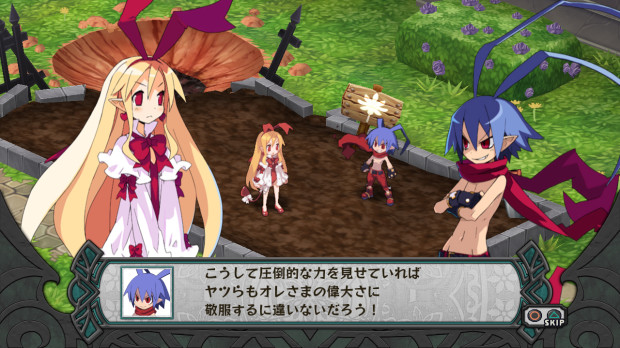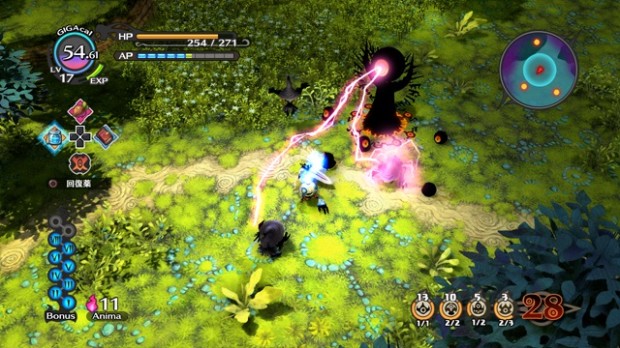NIS America Preview: Disgaea D2: A Brighter Darkness, The Guided Fate Paradox, and The Witch and the Hundred Knights
Recently, I had the opportunity to sit down and talk with a representative from NIS America about their upcoming games. The three titles I was able to get a glimpse at were Disgaea D2: A Brighter Darkness, The Guided Fate Paradox, and The Witch and the Hundred Knights. While these were only demonstrations and I was unable to get my hands on them, what was shown to me was more than enough to get excited about.
The first title shown to me was Disgaea D2: A Brighter Darkness, a nearly-direct sequel to the popular Disgaea: Hour of Darkness. What I mean by this is that D2 is set in an alternate reality (hence the title), with some elements of the world being quite different. Fan-favorite characters like Etna and Flonne do return again, though in a much happier world, as environments in the game utilize much happier colour palates. Where other titles always looked dark and gloomy, D2 features brighter tones like lush forest greens and light blue, icy winter wonderlands. When asked whether it was a direct sequel or an alternate telling, the rep on hand referred to it as a bit of both, so we won’t really know more than that until launch. What we do know, however, is how it looks and plays. For the most part, many of the gameplay elements from a Disgaea title are there; you have your hub world where you visit between battles to equip and upgrade your party, and the Item World makes a return as well. Speaking of the infinite dungeons of Item World, it was mentioned that it is back and stronger than ever, so it seems like a lot of unknown surprises wait on that front.
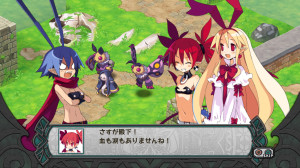 While in a battle, things proceed like any other Disgaea game, where players move their party members across the board, make an attack, use items and abilities, and then end their turn – basic mechanics any fan would know instantly. Two new and interesting features present themselves here through the forms of what I’m going to call the “master/apprentice” and “piggybacking” mechanics. I’m labeling these as such because apparently, the game is still going through translation and localization, so the final names of these features has yet to be finalized.
While in a battle, things proceed like any other Disgaea game, where players move their party members across the board, make an attack, use items and abilities, and then end their turn – basic mechanics any fan would know instantly. Two new and interesting features present themselves here through the forms of what I’m going to call the “master/apprentice” and “piggybacking” mechanics. I’m labeling these as such because apparently, the game is still going through translation and localization, so the final names of these features has yet to be finalized.
For “master/apprentice”, while outside of battle, gamers may connect two party members together as a teacher and a student. Doing this, the student character receives a stat buff from the teacher’s main attributes, while also increasing those stats slightly in the master role. By doing this, players will be able to tailor their characters a little bit more, such as binding a mage to a tank character for an extra magic boost for the tank. In theory, you could either link to similar classes to boost up their already powerful specializations, or link dissimilar characters to augment their weaker statistics. “Piggybacking”, on the other hand, takes place on the battlefield. In a similar fashion as Disgaea 3’s Magichange, players can have different human characters interact with their monster companions. Simply walk up behind a monster, and have it pick up the human. From here, that character rides the monster, and is capable of using very powerful attacks and abilities otherwise unavailable. However, this also makes the rider/monster combo a target, as both lose HP when damaged. Unlike Magichange though, players may have the character dismount on a new turn, splitting the team up again.
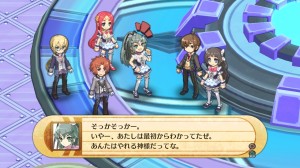 Shifting things over a bit, I was shown The Guided Fate Paradox (GFP) next. In this upcoming title, you play as a boy who wins a mysterious lottery and becomes a god – with this new career path, you get to dictate the life and events of your peers around you. While this may seem like an interesting concept, GFP focuses more on gameplay, which is what the rep described as a rouge-type game. Basically, GFP is based around the Disgaea engine, though it features many key differences. Like in the Disgaea series, GFP features a central hub for the gamer to hang out in and customise/upgrade characters, and in essence it is still a strategy game. However, the actual gameplay differs in many ways. Foremost, players don’t outright enter a battle like in Disgaea, they instead enter a randomly generated dungeon (think Dark Cloud or Chocobo’s Dungeon). From here, you move freely with any support characters following close by. Your objective is to navigate the dungeon and find the entrance to the next floor, eventually reaching a bottom. As you run into enemies, you can attack or move freely, but every single action you take will lead to a reaction from your enemies and team – as though that action automatically ended a turn. While it feels a lot more like an action game than Disgaea, you still need to think carefully and make smart decisions, as you’re essentially engaging in a very fast-paced, turn-based strategy match.
Shifting things over a bit, I was shown The Guided Fate Paradox (GFP) next. In this upcoming title, you play as a boy who wins a mysterious lottery and becomes a god – with this new career path, you get to dictate the life and events of your peers around you. While this may seem like an interesting concept, GFP focuses more on gameplay, which is what the rep described as a rouge-type game. Basically, GFP is based around the Disgaea engine, though it features many key differences. Like in the Disgaea series, GFP features a central hub for the gamer to hang out in and customise/upgrade characters, and in essence it is still a strategy game. However, the actual gameplay differs in many ways. Foremost, players don’t outright enter a battle like in Disgaea, they instead enter a randomly generated dungeon (think Dark Cloud or Chocobo’s Dungeon). From here, you move freely with any support characters following close by. Your objective is to navigate the dungeon and find the entrance to the next floor, eventually reaching a bottom. As you run into enemies, you can attack or move freely, but every single action you take will lead to a reaction from your enemies and team – as though that action automatically ended a turn. While it feels a lot more like an action game than Disgaea, you still need to think carefully and make smart decisions, as you’re essentially engaging in a very fast-paced, turn-based strategy match.
One major highlight for GFP is its equipment system, which is central to gameplay. As you buy or find equipment around the world or dungeons, you can equip it at any time – even in mid-battle inside of a dungeon. Each piece comes with its traditional stats, an attack, and a graphic to customise your character. An example of this would be if you find tank tread legs, you can literally become half man (or god, if you prefer) and half tank – with the attack being a burnout across some poor fool’s face. This system has the potential to be very deep and strategic, and I look forward to finding out just how much depth it has.
Possibly the most exciting part of the demonstration, though, would be The Witch and the Hundred Knights (WHK for short). While still being developed for release in Japan, the raw and early build I saw certainly had a lot of promise. While very little was given in ways of story, we know that the tale revolves around a certain witch. Her English name has yet to be determined, but the Japanese name for her is Metallica (not played by James Hetfield, unfortunately). She controls a legion of small, devilish knights, whom the player takes control of – one main knight and several sub-knights. At this point, we’re unsure if the witch and her legion are benevolent or malevolent, only that they are key to the story.
WHK plays as a dungeon crawler, very similar to Torchlight. Navigating a level, players will encounter various traps and enemies. To defeat them, the gamer uses up to five-hit combos, with a cooldown meter preventing them from outright spamming attacks. The form of these combinations is determined by your equipment. A single weapon can be for each specific hit of the combo, such as sword, axe, kunai, kunai, mace – using those items once per swing, in that order. Different orders and mixes of tools will result in various different onslaughts, and certain specific combinations will allow for extra damage multipliers. Throw in an art style that looks like a dark mix between Kirby and Final Fantasy: Crystal Chronicles, as well as a fully rotatable 360 degree camera, and you have a potential winner on your hands. While the glimpse I got at the title was considerably short, the small amount of information and gameplay I received gave the title a huge allure. Hopefully some more information on the game, namely in the story department will be released soon, as this is one title that I can’t help but get excited for.
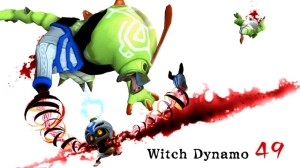 While my time with these games was fairly short, they all left something memorable and intriguing in my mind. Be it Disgaea D2: A Brighter Darkness’s new and upbeat design, The Guided Fate Paradox’s interesting story concept and fast-paces strategy action, or The Witch and the Hundred Knight’s fresh-looking take on the dungeon crawling template, each and every game has something to look forward to. Stay tuned for more on each game as they come closer to release, and for full reviews at or around launch!
While my time with these games was fairly short, they all left something memorable and intriguing in my mind. Be it Disgaea D2: A Brighter Darkness’s new and upbeat design, The Guided Fate Paradox’s interesting story concept and fast-paces strategy action, or The Witch and the Hundred Knight’s fresh-looking take on the dungeon crawling template, each and every game has something to look forward to. Stay tuned for more on each game as they come closer to release, and for full reviews at or around launch!
Disgaea D2: A Brighter Darkness is set for release on October 8th, 2013, while dates for The Guided Fate Paradox and The Witch and the Hundred Knights have yet to be determined.
About This Post
